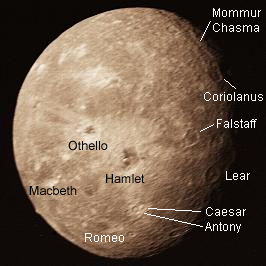Oberon (moon)
Oberon is the outermost major moon of the planet Uranus and the second largest of its moons, after Titania. It was discovered by William Herschel on January 11, 1787, the same day he discovered Titania. Oberon is named after a character from Shakespeare's play A Midsummer Night's Dream, following the naming convention for Uranus' moons of adopting names from literature. This moon is composed of equal parts ice and rock, and it is likely differentiated into a rocky core and an icy mantle. The surface of Oberon, which is dark and slightly red in color, is covered by numerous impact craters, some with bright rays, and by chasmata (long, deep depressions) suggesting ancient geological activity.
Discovery and Naming[edit | edit source]
Oberon was discovered by William Herschel using a 40-foot telescope, one of the largest telescopes of his time. The discovery of both Oberon and Titania marked the first time a moon had been discovered around Uranus, expanding our knowledge of the solar system. The name "Oberon," along with the names of the other four moons Herschel initially discovered, was suggested by his son, John Herschel, in 1852, drawing from Shakespearean characters to maintain a thematic naming convention initiated by Herschel for Uranian satellites.
Orbit and Rotation[edit | edit source]
Oberon orbits Uranus at a distance of about 583,520 kilometers (362,570 miles), making it the furthest of the planet's five major moons. It completes an orbit around Uranus every 13.46 days, and like most moons in the solar system, it is tidally locked with its planet, meaning the same side always faces Uranus. This synchronous rotation keeps one hemisphere of Oberon in perpetual darkness while the other faces the Sun at different times during its orbit.
Physical Characteristics[edit | edit source]
Oberon has a diameter of about 1,522 kilometers (946 miles), making it the second-largest moon of Uranus. Its surface is characterized by numerous impact craters, with the largest known as Hamlet, and it also features a complex network of chasmata. The moon's surface composition is believed to be roughly equal parts water ice and rock, suggesting a differentiated interior with a rocky core and an icy mantle. Oberon's surface shows signs of past geological activity, but it appears to be geologically inactive today.
Surface Features[edit | edit source]
The surface of Oberon is heavily cratered and is the darkest of Uranus' moons, though it has a slightly red tint, suggesting the presence of complex organic molecules. The largest crater, Hamlet, and other craters like Othello and Macbeth, are named after Shakespearean characters, continuing the literary theme. Oberon's chasmata, such as Mommur Chasma, indicate that the moon may have experienced tectonic activity in the past that led to its current topography.
Exploration[edit | edit source]
To date, the most significant source of information about Oberon comes from the Voyager 2 flyby in 1986. Voyager 2's close approach to Uranus allowed it to capture detailed images of Oberon, revealing its heavily cratered surface and providing data on its size, composition, and other physical characteristics. No missions have been specifically targeted to explore Oberon or the other Uranian moons since then, but future missions to the Uranian system have been proposed to further study these intriguing worlds.
Conclusion[edit | edit source]
Oberon remains an object of interest for astronomers and planetary scientists due to its unique characteristics among the moons of Uranus. Its heavily cratered surface, evidence of past geological activity, and the mystery of its dark, slightly red coloration make it a compelling subject for future exploration. As our understanding of the outer solar system continues to grow, Oberon will undoubtedly play a key role in unraveling the complex history and dynamics of Uranian satellites.
Search WikiMD
Ad.Tired of being Overweight? Try W8MD's physician weight loss program.
Semaglutide (Ozempic / Wegovy and Tirzepatide (Mounjaro / Zepbound) available.
Advertise on WikiMD
|
WikiMD's Wellness Encyclopedia |
| Let Food Be Thy Medicine Medicine Thy Food - Hippocrates |
Translate this page: - East Asian
中文,
日本,
한국어,
South Asian
हिन्दी,
தமிழ்,
తెలుగు,
Urdu,
ಕನ್ನಡ,
Southeast Asian
Indonesian,
Vietnamese,
Thai,
မြန်မာဘာသာ,
বাংলা
European
español,
Deutsch,
français,
Greek,
português do Brasil,
polski,
română,
русский,
Nederlands,
norsk,
svenska,
suomi,
Italian
Middle Eastern & African
عربى,
Turkish,
Persian,
Hebrew,
Afrikaans,
isiZulu,
Kiswahili,
Other
Bulgarian,
Hungarian,
Czech,
Swedish,
മലയാളം,
मराठी,
ਪੰਜਾਬੀ,
ગુજરાતી,
Portuguese,
Ukrainian
Medical Disclaimer: WikiMD is not a substitute for professional medical advice. The information on WikiMD is provided as an information resource only, may be incorrect, outdated or misleading, and is not to be used or relied on for any diagnostic or treatment purposes. Please consult your health care provider before making any healthcare decisions or for guidance about a specific medical condition. WikiMD expressly disclaims responsibility, and shall have no liability, for any damages, loss, injury, or liability whatsoever suffered as a result of your reliance on the information contained in this site. By visiting this site you agree to the foregoing terms and conditions, which may from time to time be changed or supplemented by WikiMD. If you do not agree to the foregoing terms and conditions, you should not enter or use this site. See full disclaimer.
Credits:Most images are courtesy of Wikimedia commons, and templates, categories Wikipedia, licensed under CC BY SA or similar.
Contributors: Prab R. Tumpati, MD


